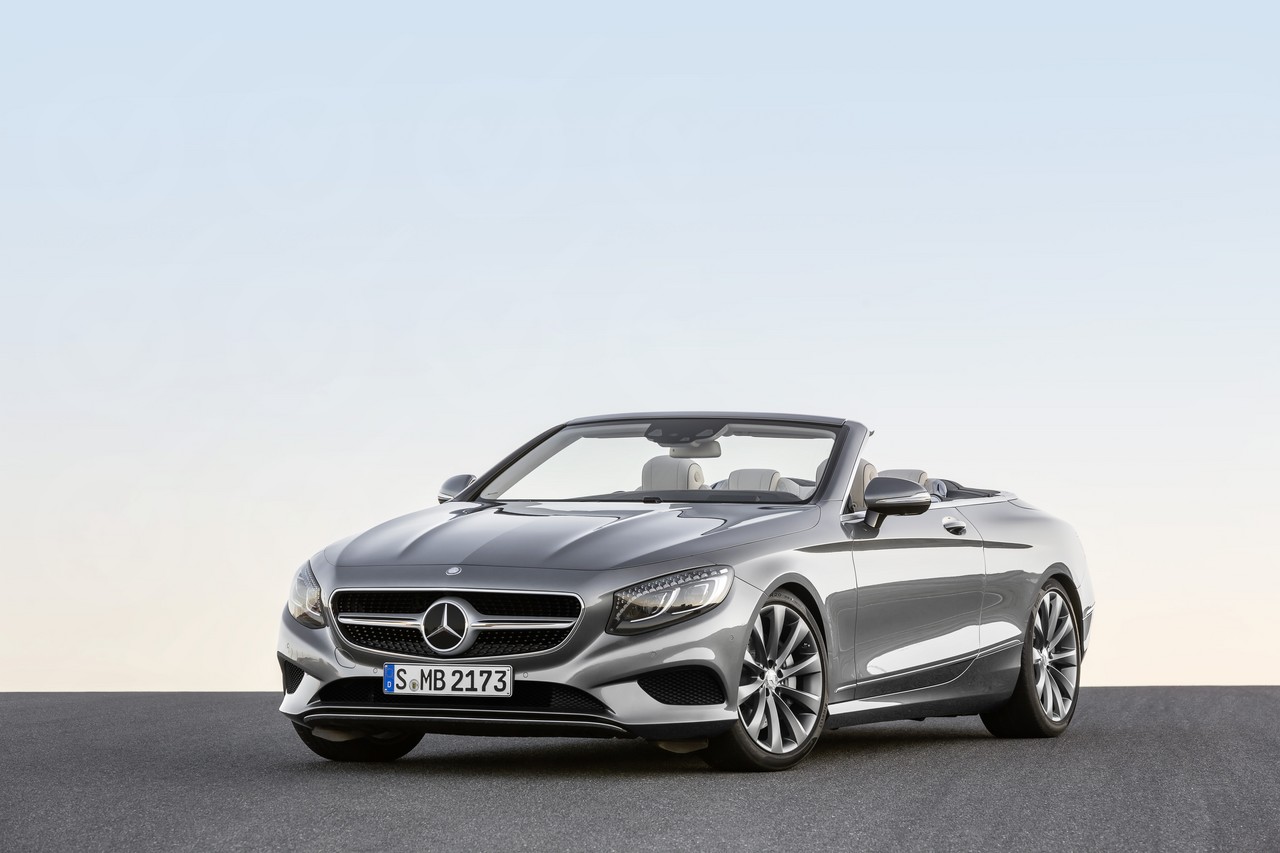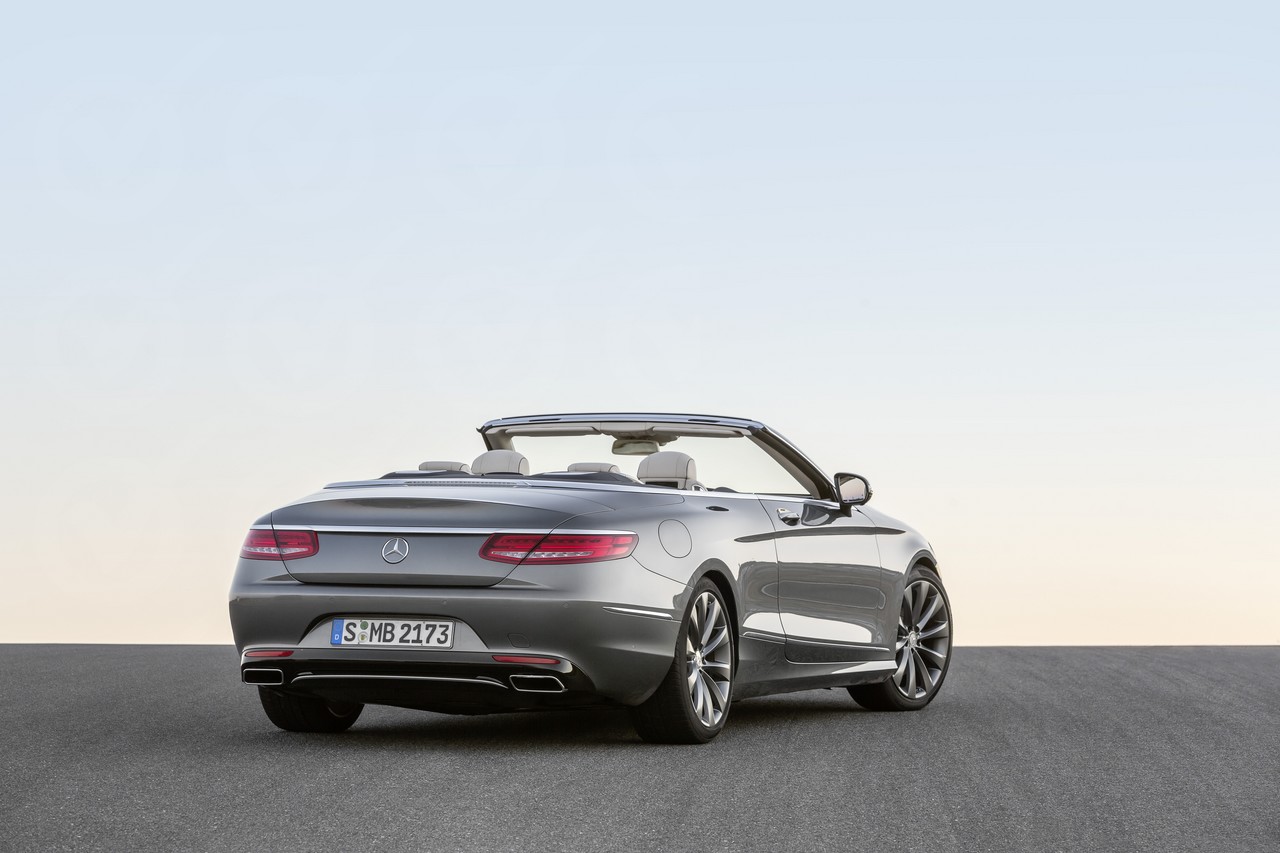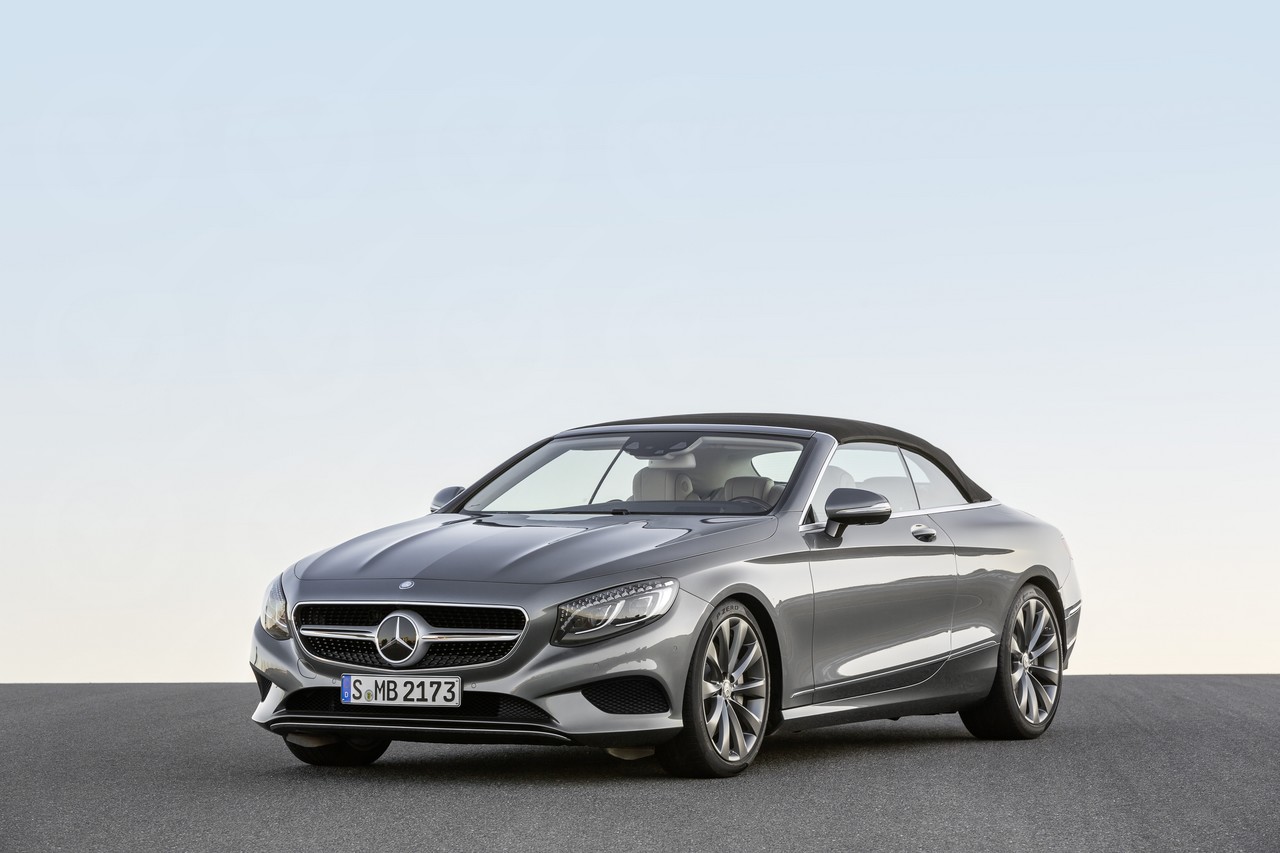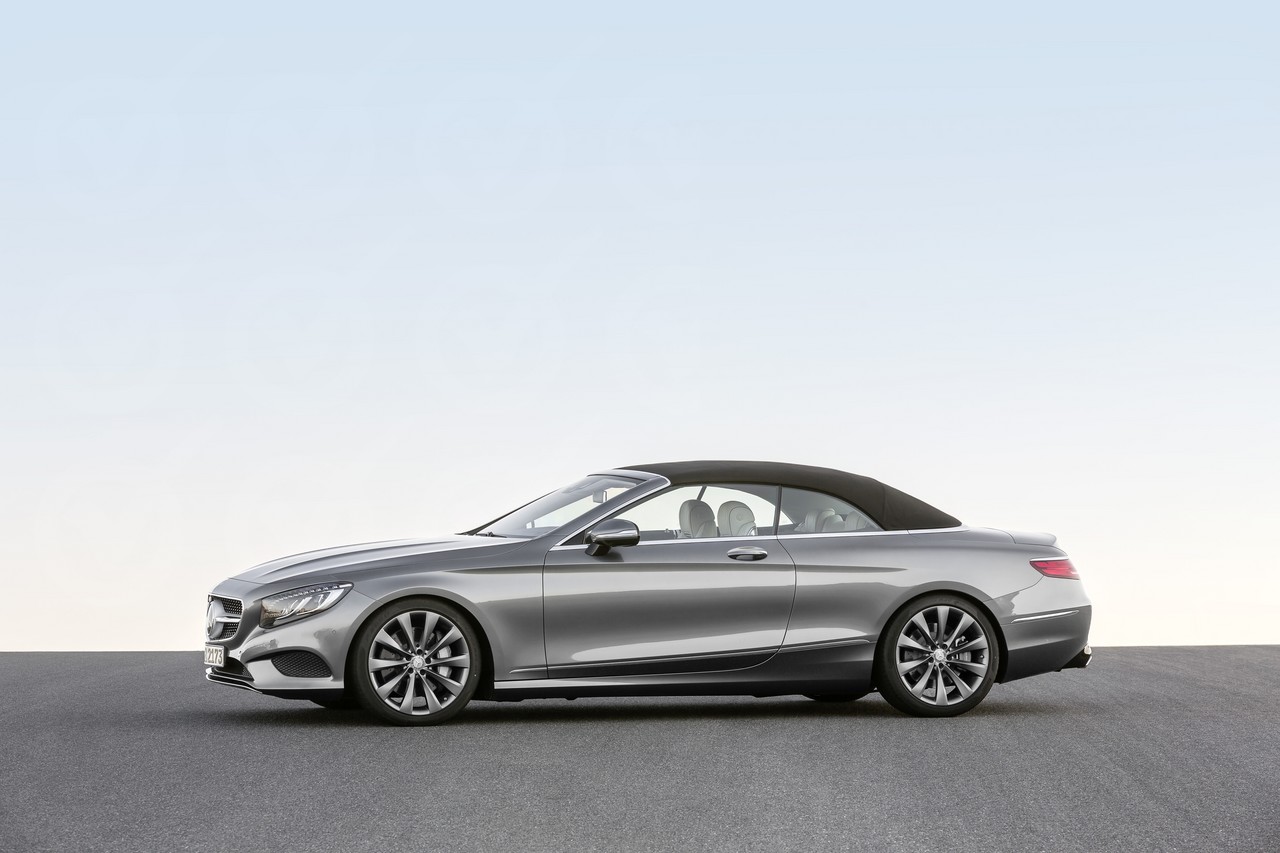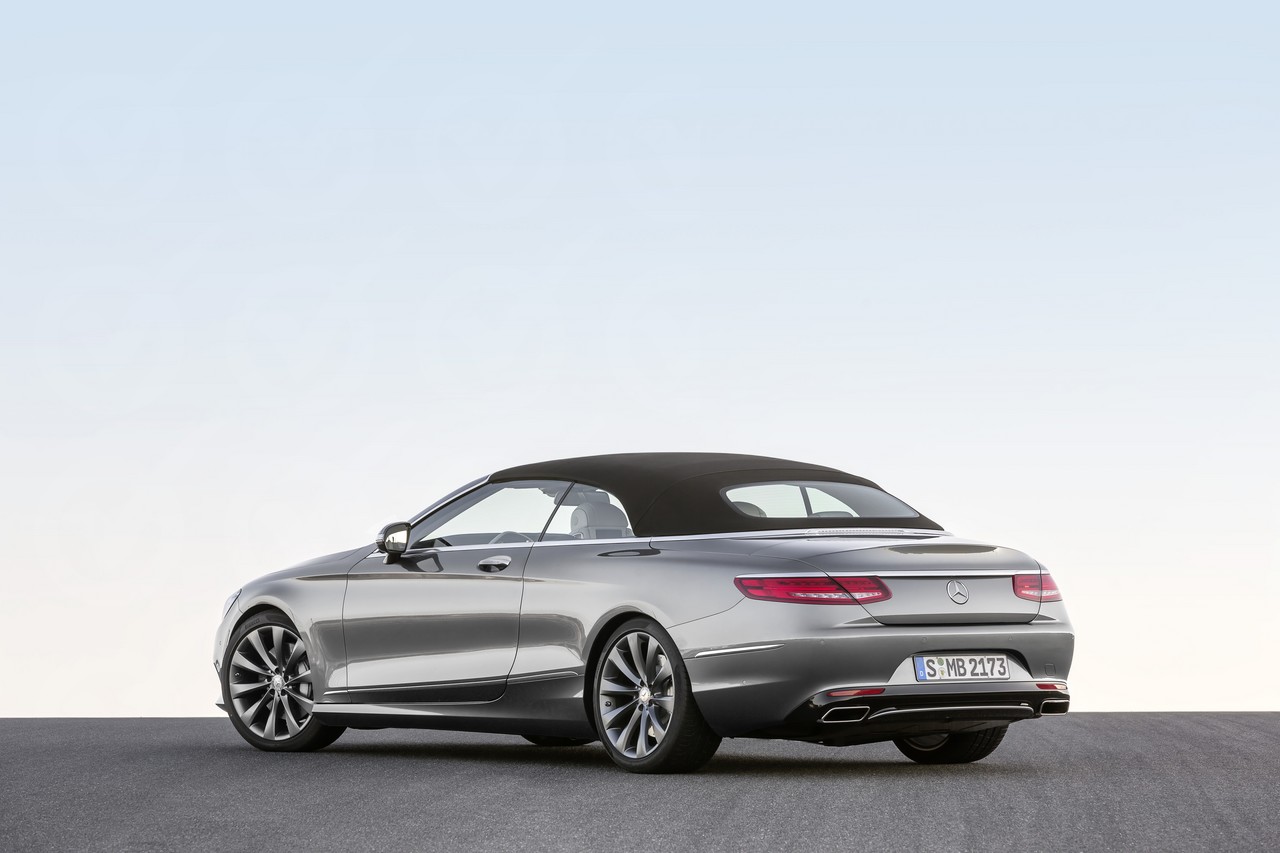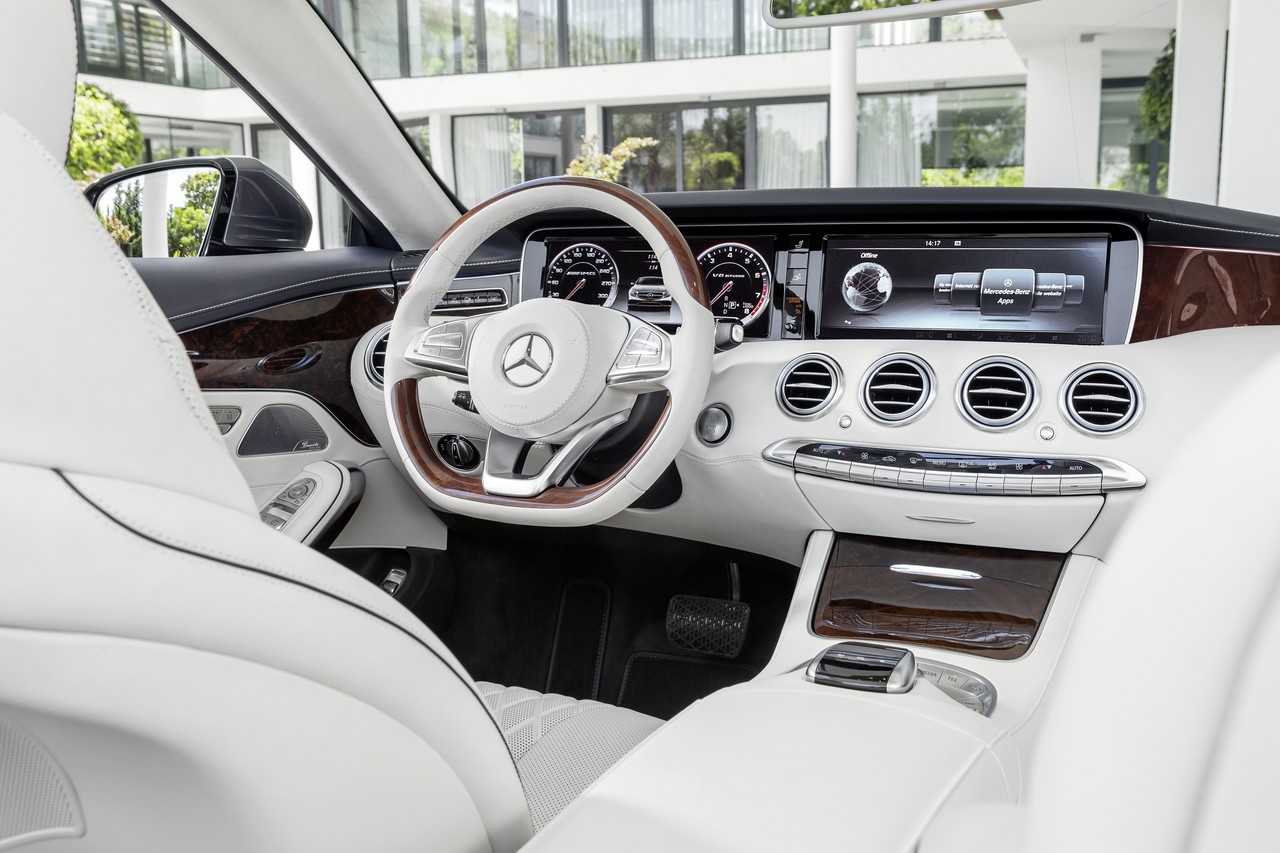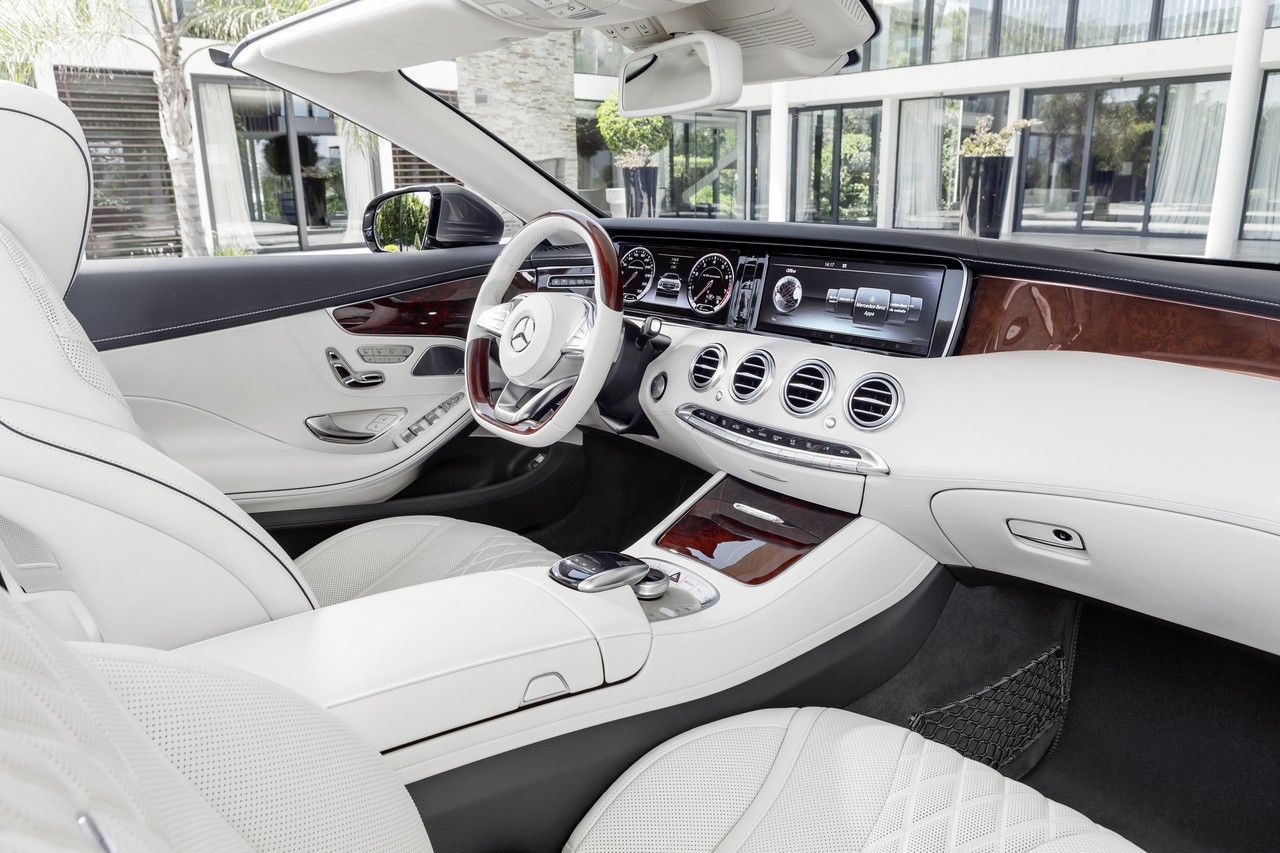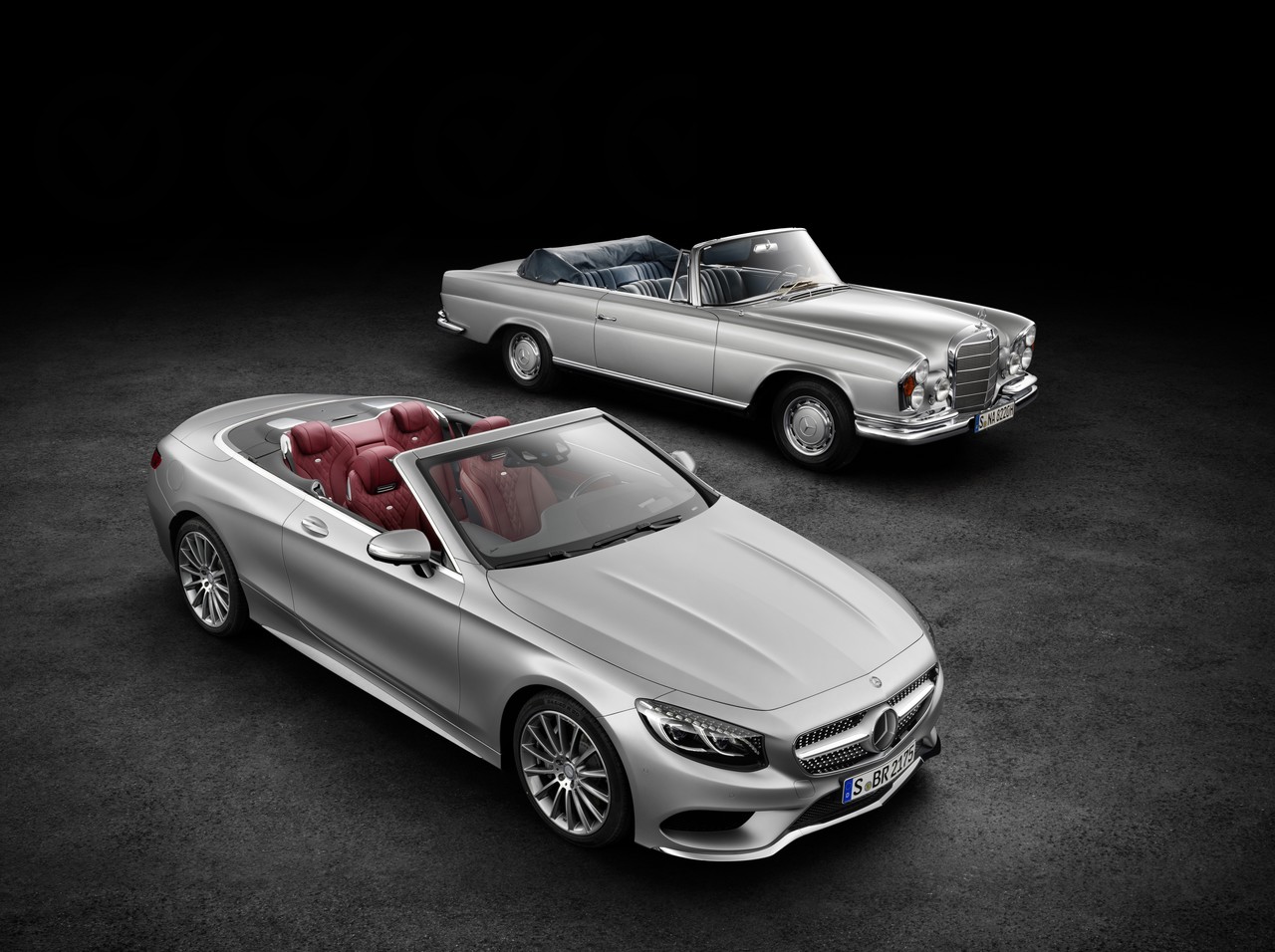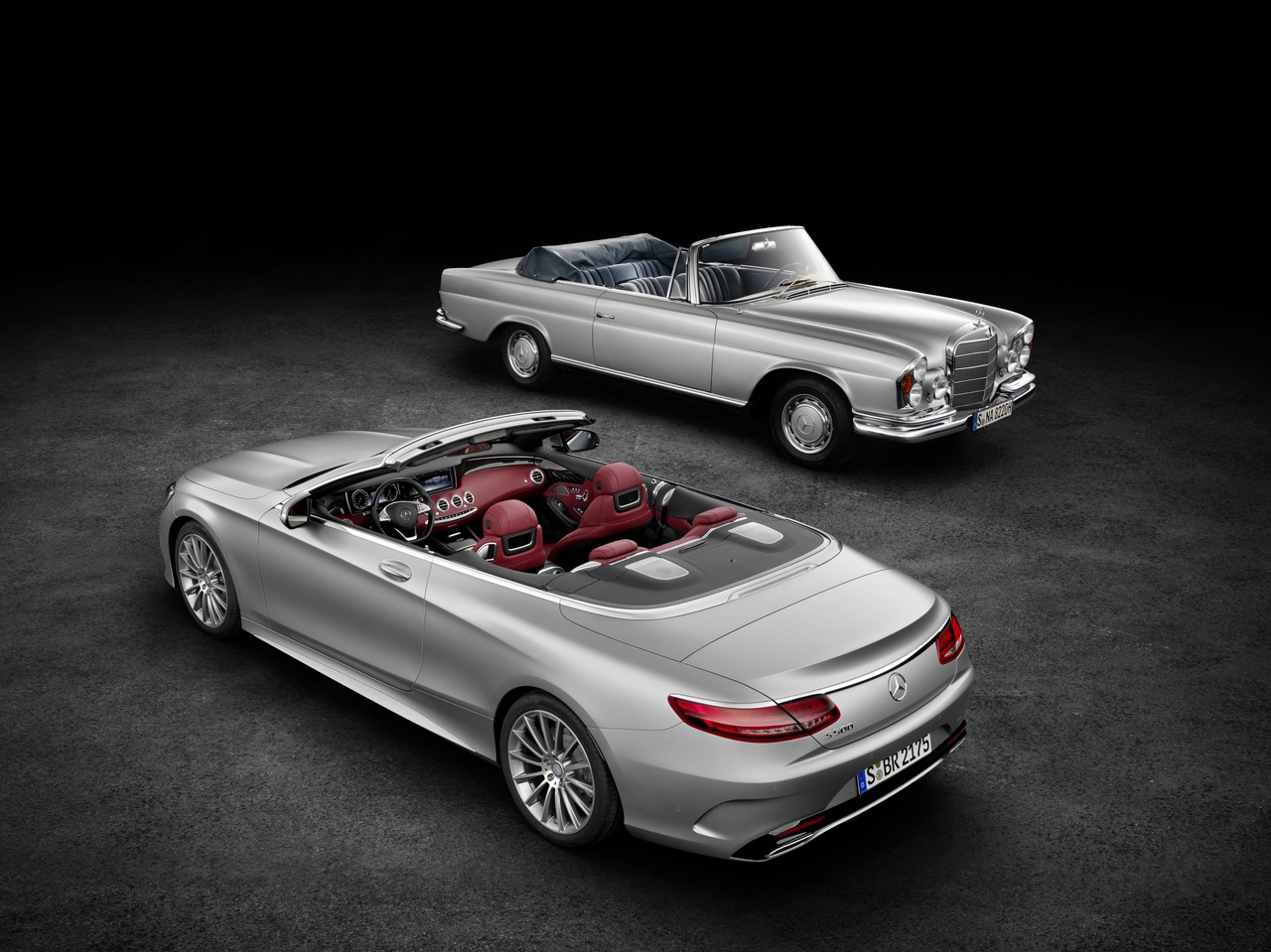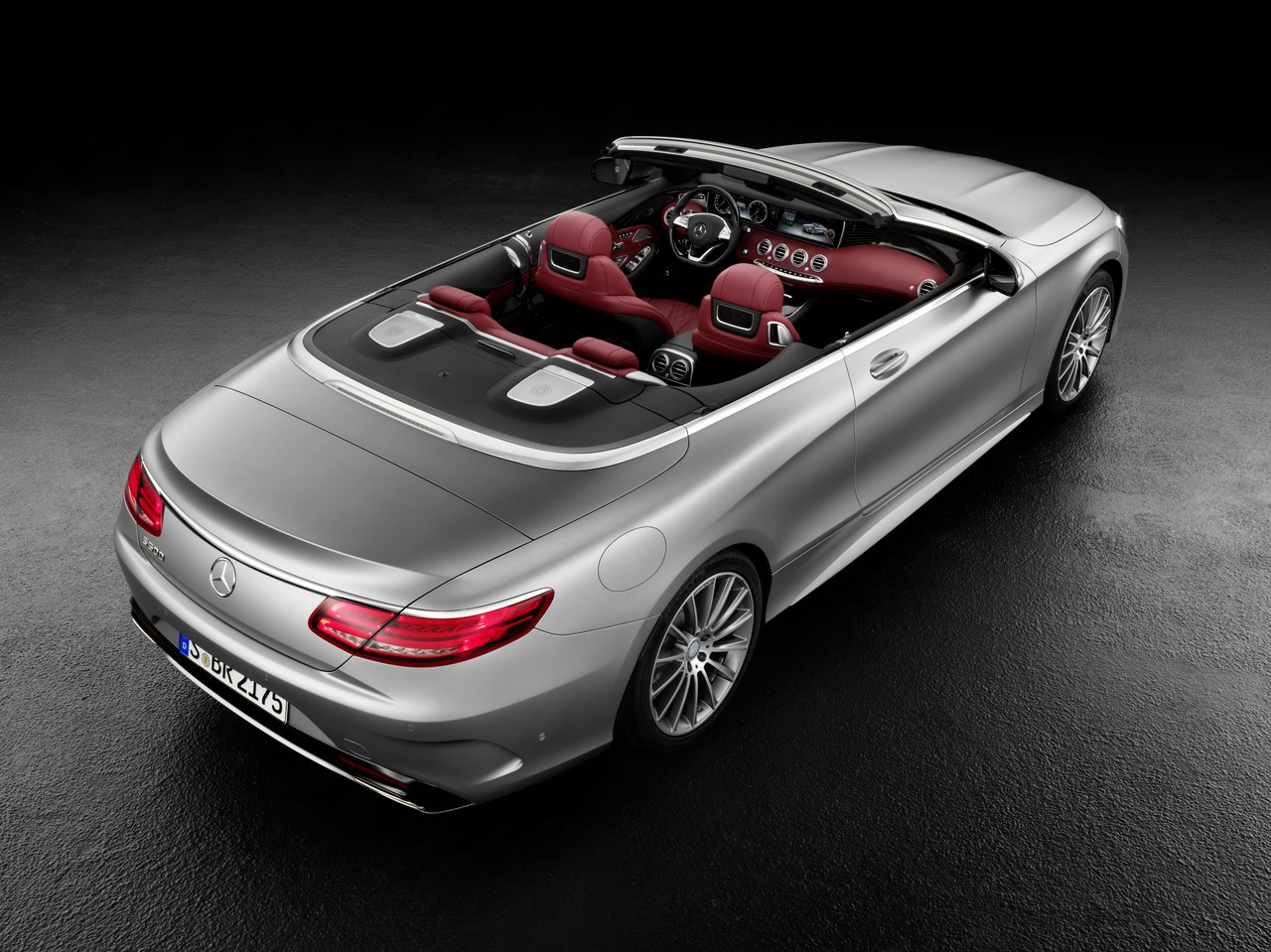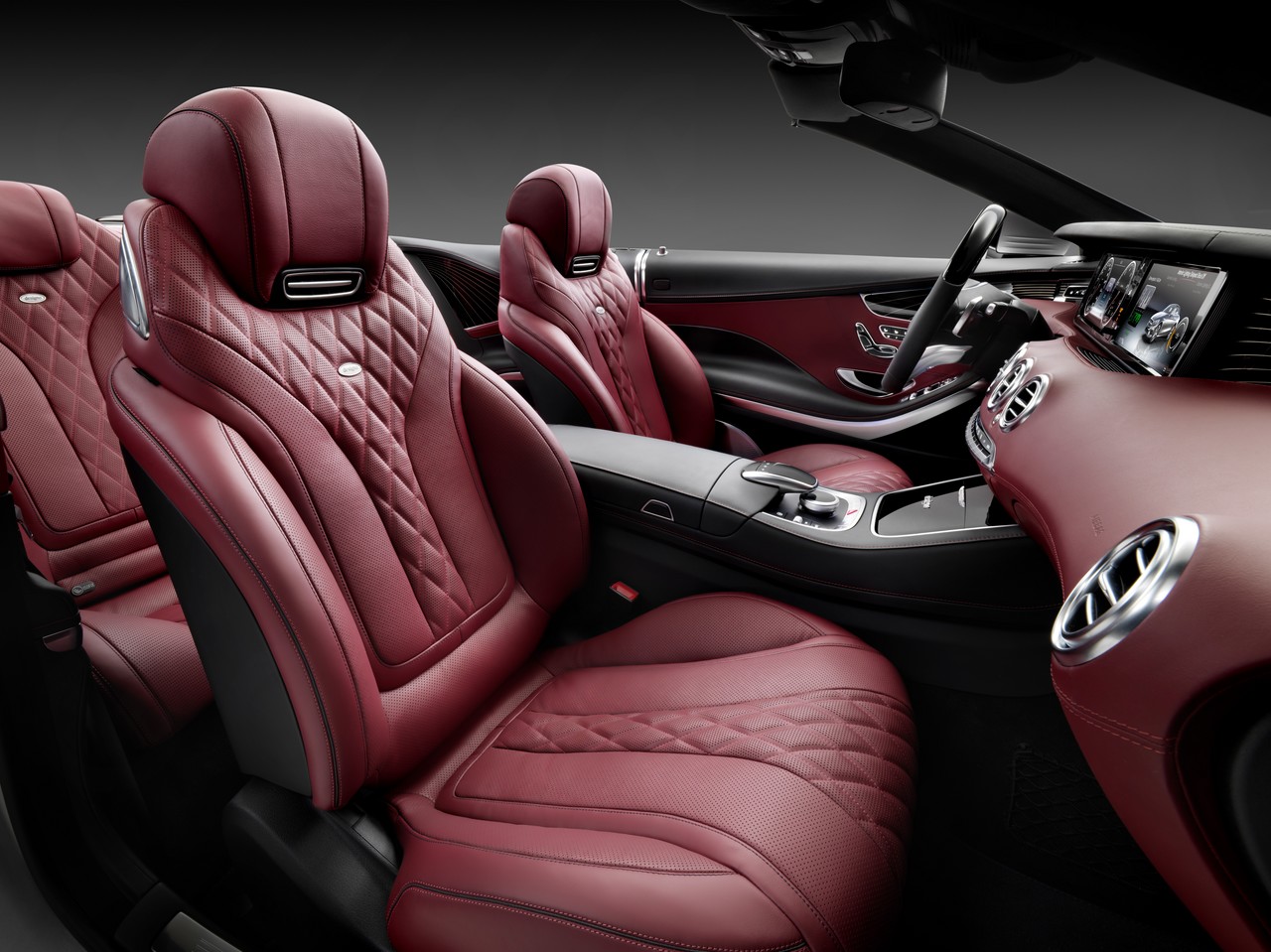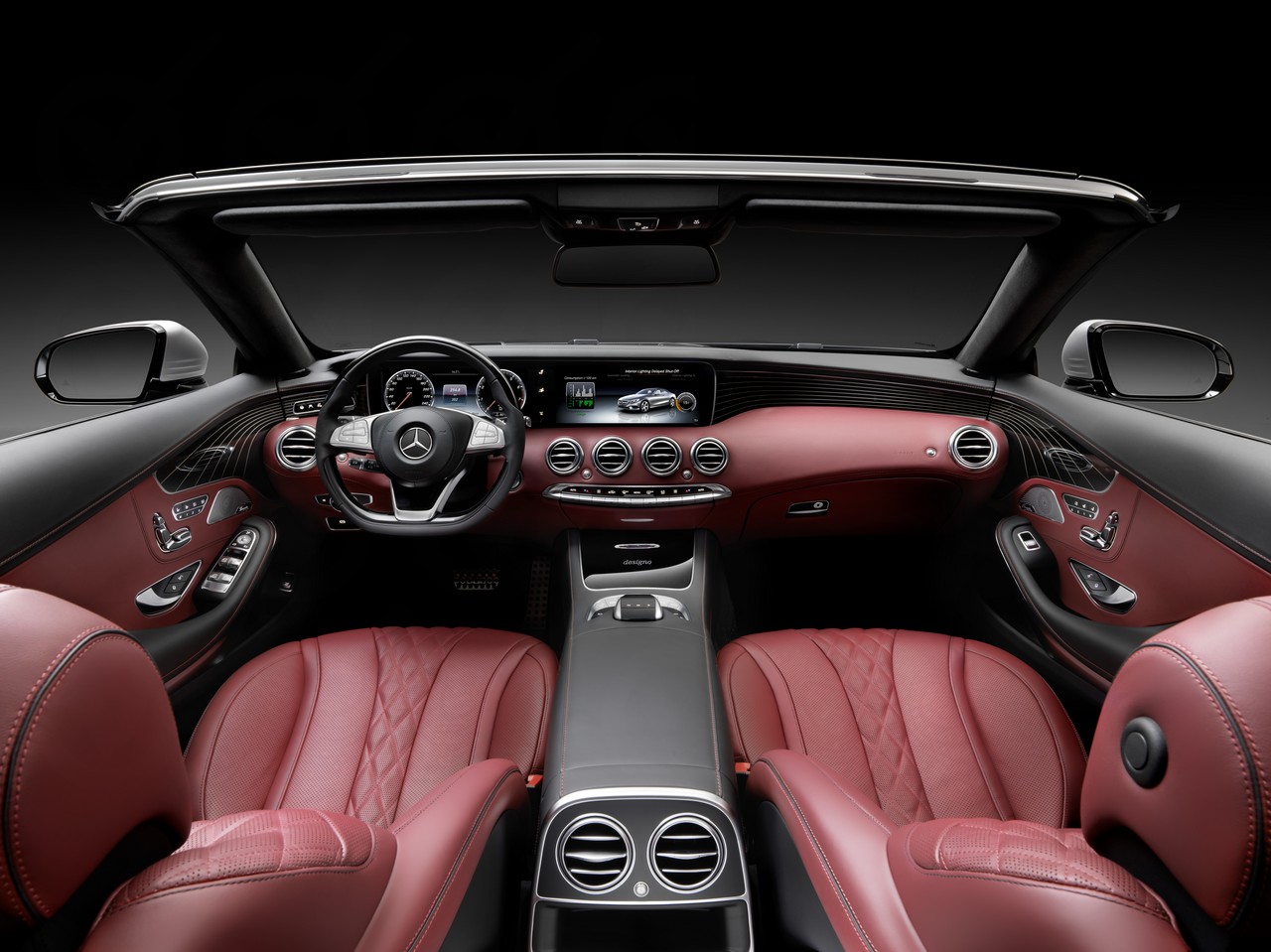
- Responsive 4.7-litre M278 bi-turbo V8 engine
- Nine-speed transmission aids fuel economy
- Excellent ride/handling balance
- High standard of interior fit and finish
- Limited boot space
- High running, maintenance and depreciation costs
Overview
Released in Australia in October 2016, the Mercedes-Benz A217 S-Class Cabriolet is a four-seat convertible with a soft-top roof. Manufactured in Sindelfingen, Germany, the Mercedes-Benz A217 S-Class Cabriolet range was limited to the S 500 model which was powered by a 4.7-litre twin-turbo V8 petrol engine and had a nine-speed automatic transmission.
Please note that the Mercedes-AMG A217 S-Class Cabriolet has been reviewed separately.
| Engine | Trans. | Peak power | Peak torque | |
|---|---|---|---|---|
| S 500 Cabriolet | 4.7-litre twin-turbo petrol V8 (M278 DE46 AL) | 9sp auto | 335 kW at 5250 rpm | 700 Nm at 1800-3500 rpm |
Body and dimensions
The Mercedes-Benz A217 S-Class Cabriolet adopted around 60 per cent of the bodyshell components of the C217 S-Class Coupe . Changes, however, included:
- A new aluminium rear floor (which increased the proportion of lightweight metal – by surface area – to over 50 per cent);
- Die-cast aluminium longitudinal members. With the aid of a sand core, the longitudinal member was produced as a closed cast body which was hollow inside – this enabled various components to be integrated in the longitudinal member while making varying wall thicknesses. The technology for these longitudinal members was first developed for the Mercedes-Benz R231 SL-Class ;
- A reinforcing rear wall which was positioned behind the rear seats, supported the pyrotechnically extending roll bars and had a through-loading opening into the luggage compartment. To minimise mass, the reinforcing wall had two magnesium shear panels and aluminium covering sections; and,
- Reinforcements on the underfloor to enhance the body’s rigidity.
Compared to the Mercedes-Benz C217 S-Class Coupe , the A217 S-Class Cabriolet was 17 mm longer (at 5044 mm), 13 mm wider (1912 mm) and 17 mm taller (1428 mm), though wheelbase length was unchanged at 2945 mm. Furthermore, the S-Class Cabriolet had a drag coefficient of 0.29 Cd, in part due to its underbody panelling for the engine compartment, main floor and rear axle, and wheel spoilers.
Soft-top roof
The Mercedes-Benz A217 S-Class Cabriolet had a three-layer acoustic roof. The outer fabric cover incorporated a butyl layer as a water barrier and, in conjunction with enhanced upholstery matting and the acoustically optimised roof lining, reduced interior noise. The roof could open or close in approximately 20 seconds and be operated at speeds up to 60 km/h. When closing the soft top, the necessary closing forces were generated by moving the tensioning arms beyond the dead centre position (i.e. ‘overcentering’) to remove the need for any additional closures on the soft top compartment lid. Furthermore, the roof was available in black, dark blue, beige and dark red colours.
‘Airmatic’ air suspension
The Mercedes S-Class Cabriolet had four-link front suspension and multi-link independent rear suspension, both with air springs, monotube shock absorbers (with two valves for the rebound and compression stages) and anti-roll bars. Fitted as standard, the ‘Airmatic’ air suspension system had continuously adaptive damping (Mercedes-Benz’s ‘Adapting Damping System’) which allowed spring travel to be maintained regardless of vehicle load. The driver could also select from ‘Sport’ and ‘Comfort’ damper configurations.
When driving at higher speeds, the suspension would lower the vehicle by 10 mm to reduce aerodynamic drag and improve handling stability. However, the lower control panel on the centre console enabled the driver to raise the vehicle by 40 mm for poor road surfaces.
Steering
The Mercedes S-Class Cabriolet had rack-and-pinion steering with speed-sensitive, electric power assistance and a variable steering ratio. In the steering system, the steering gear and supporting servomotor formed a single compact unit and were mounted on an aluminium frame.
Safety equipment
Standard safety equipment for the Mercedes-Benz A217 S-Class Cabriolet included dual front airbags, a driver’s knee airbag, thorax-pelvis sidebags integrated in the sides of the front seats, headbags for the front passengers that were installed in the beltline area of the doors, rear sidebags that were integrated into the bodyshell in the area of the rear interior side panels, ABS, brake assist, electronic brake force distribution, electronic stability control, traction control and front and outer rear seatbelts with pre-tensioners and load limiters.
As standard, Australian-delivered Mercedes-Benz A217 S-Class Cabriolet vehicles had the following technologies –
- Pre-Safe Brake with pedestrian detection (autonomous emergency braking): using two 24 GHz sensors behind the front bumper which had a range of 30 metres and a 77 GHz radar which had a range of 200 metres, Pre-Safe Brake operated at speeds between 30 km/h and 200 km/h, and at speeds below 70 km/h if the vehicle was approaching a stationary queue of traffic. Around 2.6 seconds before the anticipated moment of impact, an audible warning would sound and a red warning would appear in the tachometer. Around 1.6 before the calculated impact, the first stage of Pre-Safe Brake would initiate partial braking autonomously with around 40 per cent of the maximum braking power (approximately four (4) m/s2); the Pre-Safe occupant protections system would also be activated. If the driver then applied the brakes, maximum braking force would be made available. If the driver failed to react, Pre-Safe Brake would – in its second stage – initiate autonomous emergency braking (i.e. maximum braking power) around 0.6 seconds before the unavoidable collision to reduce the severity of the impact. The pedestrian recognition function enabled Pre-Safe Brake to detect pedestrians when driving at speeds of up to 50 km/h;
- Distronic Plus (adaptive cruise control with brake warning): an ‘adaptive’ cruise control system which used two short-range radar sensors positioned behind the front bumper to monitor the road up to 30 metres ahead, and a long-range radar located behind the radiator grille which had a range of 200 metres. Operating at speeds up to 200 km/h, Distronic Plus used an electronic control unit to analyse the information from both radar systems to calculate the engine, automatic transmission and braking parameters required for proximity control. As such, Distronic Plus could automatically apply the brakes to prevent the vehicle from becoming too close to traffic ahead (the time interval could be specified) and accelerate back to the set speed when traffic allowed. To accelerate from rest, the driver only needed to operate the Distronic stalk on the steering column or briefly depress the accelerator pedal. With Distronic Plus, automatic deceleration of up to four (4) m/s2was possible. If Distronic Plus detected that heavier braking was required, a warning light would illuminate in the instrument cluster and be accompanied by an audible warning. Furthermore, the electronic proximity control system could be activated independently of Distronic Plus at speeds over 30 km/h to alert the driver if they were approaching another vehicle too rapidly;
- Steering Assist with Stop&Go Pilot: operating in conjunction with Distronic Plus and at speeds up to 130 km/h, Steering Assist used a stereo camera located behind the windscreen to detect road markings, while the Stop&Go Pilot operated at speeds up to 60 km/h and enabled the system to use the vehicle in front or road markings as a means of orientation. If the vehicle was detected to be drifting out of its lane, Steering Assist would warn the driver and provide steering intervention to keep the vehicle in its lane;
- BAS Plus with Cross-Traffic Assist: used a 24 GHz radar sensor with a range of 30 metres and a 77 GHz radar sensor with a range of 200 metres to monitor the distance to the vehicle ahead and would warn the driver if there was a risk of a collision. Brake Assist Plus could detect vehicles when travelling at speeds up to 200 km/h, and stationary objects when the driver was travelling at 7 km/h to 72 km/h. Significantly, Brake Assist Plus could calculate the necessary brake force assistance to prevent a rear-end collision, build up that pressure in the braking system and provide it as soon as the brake pedal was depressed for ‘the best possible deceleration’. The Cross-Traffic Assist function could operate at speeds up to 72 km/h and used the stereo camera and radar sensors to detect traffic that was crossing in front of or behind the vehicle. If detected, the driver would receive visual and audible alerts;
- Pre-Safe Impulse: if a lateral collision was imminent, Pre-Safe impulse side moved the driver or front passenger laterally away from the danger zone by inflating an air chamber in the side bolster of the front seat backrest nearest the side of the imminent impact – this increased the distance between occupant and door, thereby reducing the forces acting on the occupants;
- Pre-Safe Plus: could anticipate rear-end collisions and warn following traffic by flashing the rear hazard warning lights at high frequency;
- Active Blind Spot Assist: active at speeds above 60 km/h, a corrective braking force was applied to the wheels on one side of the vehicle if the driver attempted to change lanes when a vehicle was detected in the driver’s blind spot;
- Active Lane Keeping Assist: initiated steering wheel vibrations if the vehicle approached a continuous lane marking line and, if crossed, automatically braked wheels on one side of the vehicle to return the vehicle within the lane;
- Attention Assist with adjustable sensitivity: operated at speeds in excess of 80 km/h and monitored driver behaviour and steering movements for signs of drowsiness; if detected, the driver was provided with visual and audible warnings; and,
- Crosswind Assist: could detect sudden, strong gusts of wind and prevent the vehicle from drifting out of its lane via corrective braking forces on one side of the vehicle.
The Mercedes-Benz A217 S-Class Cabriolet was also fitted with –
- A roll-over protection system which used pyrotechnic initiation of the actuators for the roll bars; and,
- An ‘active bonnet’ which, in the event of a pedestrian collision, triggered a pyrotechnic charge to raise the height of the bonnet and provide additional clearance to ‘hard points’ within the engine bay.
Wheels, tyres and brakes
The Mercedes-Benz A217 S 500 Cabriolet had 8.5J x 20-inch front alloy wheels with 245/40 R20 tyres and 9.5J x 20-inch rear alloy wheels with 275/35 R20 rear tyres. Furthermore, the S 500 Cabriolet had 370 mm by 36 mm ventilated front brake discs and 340 mm by 24 mm ventilated rear discs.
Features: Mercedes-Benz A217 S 500 Cabriolet
As standard, the Mercedes-Benz S 500 Cabriolet was equipped with the ‘COMAND Online’ media system which included a 31.2 cm colour display, HDD navigation with 3D maps and live traffic updates, a CD/DVD player, a digital radio tuner (DAB+), digital TV tuner (DVB), Bluetooth interface with hands-free function, ‘Linguatronic’ voice control, an integrated WLAN hotspot, two USB ports in the centre armrest, an SDHC memory card slot, and a 10 GB Media Register for audio storage.
Beyond this, standard features for the Mercedes-Benz S 500 Cabriolet included a 590 watt Burmester surround sound system with thirteen speakers and a nine-channel digital sound processing (DSP) amplifier, exclusive nappa leather upholstery, heated and ventilated front seats with power adjustment, ‘Thermotronic’ dual-zone climate control air conditioning, cruise control with a variable speed limiter (‘Speedtronic’), dusk-sensing headlights, rain-sensing wipers, a leather-wrapped steering wheel with gearshift paddles, remote central locking with proximity key, power adjustable and heated door mirrors with folding function, auto-dimming interior and door mirrors, power windows, a height and reach adjustable steering wheel, memory settings (for the front seats, door mirrors and steering column), an electric park brake, push-button start, ‘Dinamica’ micro-fibre roof lining, ambient lighting, illuminated vanity mirrors, brown burr walnut high gloss wood trim, velour floor mats, a tyre pressure loss warning system, a trip computer, an alarm and immobiliser.
The A217 S 500 Cabriolet was also fitted with the following Mercedes technologies –
- AirScarf neck-level heating: circulated warmed air around the head and neck areas of the occupants from the head restraints;
- AirCap wind protection system: consisted of an extendable wind deflector with a net that was set into the roof frame and an extendable draught-stop behind the rear seats;
- Active Parking Assist with Parktronic: used the front and rear parking sensors to identify suitable parallel and right angle parking spaces – when driving at speeds up to 36 km/h – and could autonomously steer the vehicle into the parking space while the driver controlled vehicle speed;
- Magic Vision Control: directed water onto the windscreen via channels in the windscreen wiper blades to keep the windscreen clean;
- A 360 degree camera system which could show the S-Class Cabriolet and its surroundings from different perspectives;
- LED Intelligent Light System: provided variable lighting and five selectable programs: motorway mode, cornering light function, camera-based active light function, roundabout light function and enhanced fog light function; and,
- Adaptive Highbeam Assist Plus: active at speeds above 30 km/h, Adaptive Highbeam Assist Plus used a camera positioned behind the windscreen to detect vehicles ahead of the S-Class Cabriolet and oncoming traffic. Using this information, Adaptive Highbeam Assist Plus provided continuous, dazzle-free high beam lights and could use a mechanism in the headlamp module to mask a portion of the cone of light from the LED headlights.
Specifications
Related links
